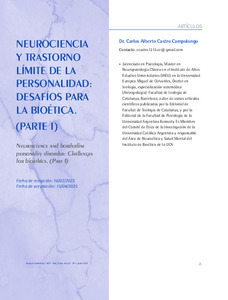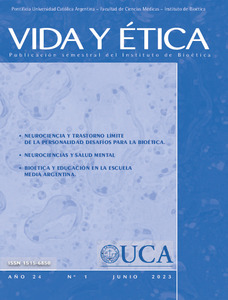Por favor, use este identificador para citar o enlazar este ítem:
https://repositorio.uca.edu.ar/handle/123456789/17065| Título: | Neurociencia y trastorno límite de la personalidad: desafíos para la bioética. (Parte I) Neuroscience and borderline personality disorder: challenges for bioethics. (Part I) |
Autor: | Castro Campolongo, Carlos Alberto | Palabras clave: | NEUROCIENCIA; TRASTORNO LIMITE DE LA PERSONALIDAD; PSIQUIATRIA; DIAGNOSTICO; TRASTORNOS MENTALES | Fecha de publicación: | 2023 | Editorial: | Educa | Cita: | Castro Campolongo, C. A. Neurociencia y trastorno límite de la personalidad: desafíos para la bioética. (Parte I) [en línea]. Vida y Etica. 2023, 24 (1). Disponible en: https://repositorio.uca.edu.ar/handle/123456789/17065 | Resumen: | Resumen:
El presente trabajo responde a algunos
interrogantes acerca de cómo realizar
un diagnóstico de Trastorno Límite
de la Personalidad (TLP), plantea la
pregunta acerca de si es suficiente
utilizar el modelo categorial, o si es el
modelo dimensional aporta novedad
significativa que ha de ser considerada.
Si debe imponerse el tratamiento
en bien del paciente, aunque él no
lo acepte. Si todos los tratamientos
tienen el mismo grado de validez y
por tanto de recomendabilidad. El
modelo dimensional puede aportar luz
como para avanzar en esta dirección
ya que rompiendo con una lógica
binaria se abre a comprender que
normalidad y patología no son cortes
sincrónicos, sino que son como puntos
en un continuo. El diagnóstico de un
trastorno mental es trascendental para
la persona, tanto para lograr su mejoría
y recuperación, como en los posibles
efectos adversos, principalmente el
estigma, el prejuicio y la discriminación
(menores oportunidades de trabajo,
cobertura médica limitada) a los que
puede dar lugar.
¿Cómo realizar un diagnóstico de
TLP? ¿Es suficiente utilizar el modelo
categorial, o el modelo dimensional
aporta novedad significativa? Abstract: This work answers some questions about how to make a diagnosis of Borderline Personality Disorder (BPD), raises the question about whether it is enough to use the categorical model, or if the dimensional model provides a significant novelty that has been considered. If the treatment should be imposed for the good of the patient, even if he does not accept it. If all treatments have the same degree of validity and therefore recommendability. The dimensional model can provide light to advance in this direction, since breaking with a binary logic opens up to understand that normality and pathology are not synchronous cuts, but rather are like points on a continuum. The diagnosis of a mental disorder is transcendental for the person, both to achieve their improvement and recovery, as well as the possible adverse effects, mainly stigma, prejudice and discrimination (fewer job opportunities, limited medical coverage) to which they can lead. How to make a diagnosis of BPD? Is it enough to use the categorical model, or does the dimensional model provide a significant novelty? |
URI: | https://repositorio.uca.edu.ar/handle/123456789/17065 | ISSN: | 1515-6850 (impreso) 2683-6998 (online) |
Disciplina: | PSICOLOGIA | Derechos: | Acceso abierto | Fuente: | Vida y Etica Año 24, No.1, 2023 |
| Aparece en las colecciones: | VE - 2023 Año 24 nro. 1 VE - 2023 Año 24 nro. 1 |
Ficheros en este ítem:
| Fichero | Descripción | Tamaño | Formato | |
|---|---|---|---|---|
| neurociencia-trastorno-límite.pdf | 180,95 kB | Adobe PDF |  Visualizar/Abrir | |
| vidayetica2023-1-portada.pdf | 168,33 kB | Adobe PDF |  Visualizar/Abrir |
Visualizaciones de página(s)
331
comprobado en 27-abr-2024
Descarga(s)
314
comprobado en 27-abr-2024
Google ScholarTM
Ver en Google Scholar
Este ítem está sujeto a una Licencia Creative Commons

